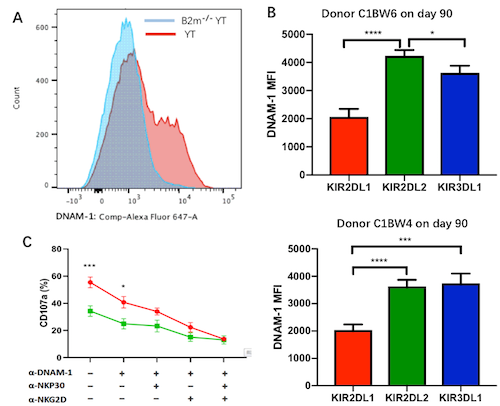
Contributions
Abstract: EP1300
Type: E-Poster Presentation
Session title: Stem cell transplantation - Experimental
Background
NK cell education is a fateful process to acquire strong responsibility through inhibitory receptors bound with MHC-I on autologous cells during NK cell development. DNAM-1 (DNAX accessory molecule-1, CD226) is a costimulatory molecule expressed by NK cells and CD8+ T cells. Interaction between DNAM-1 and its ligands on target cells triggers cell-mediated cytotoxicity and cytokine production. Previous studies illuminated the expression of DNAM-1 on NK cells was associated with inhibitory receptors KIR/NKG2A. Our previous studies have demonstrated that when both donors and recipients present all the KIR ligands for donor KIRs, reconstituted NK cells would achieve better functional education in patients post allogeneic hematopoietic stem cell transplantation (allo-HSCT). However, the mechanism that regulates DNAM-1 expression is unclear.
Aims
To explore the regulation of MHC-I on DNAM-1 expression using YT cell lines. And to investigate the influence of donor and recipient HLA on DNAM-1 expression during NK cell reconstitution and education based on the setting of allo-HSCT.
Methods
Firstly, we used crispr-cas9 to knock out HLA-I on YT cell line to study the effect of MHC-I to DNAM-1 expression. Then, we investigated the correlation of DNAM-1 expression and NK cell education during a dynamic reconstitute state in patients who had acute leukemia and underwent allo-HSCT at days 30, 90 and 180 post-HSCT. And further analyzed the relationship of donor, recipients and both HLA with DNAM-1 expression. Finally, we blocked DNAM-1 in vitro to explore whether DNAM-1 expression determined educated NK stronger function.
Results
1. B2m-/- YT cells, which had lower surface HLA-I expression, showed obviously decreased DNAM-1 expression.
2. In patients post allo-HSCT, educated NK cells displayed higher DNAM-1 expression than uneducated NK cells considering no matter donors, recipients or both HLA genotypes. DNAM-1 expression on sole-recipient HLA educated NK cells was higher than sole-donor HLA educated NK cells, indicating that recipients affected more than donors for NK education. Therefore, there was a close correlation of DNAM-1 expressions and NK education post transplantation.
3. DNAM-1 expression was positively related with inhibitory KIR/NKG2A numbers when patients presented all HLA(C1C2BW4) post-HSCT.
4. Only when DNAM-1, NKp30 and NKG2D receptors were blocked simultaneously, the function of educated and uneducated NK cells would be decreased to a similar level. So, activating receptors could be synergistic with DNAM-1 to determine NK function.

Conclusion
Both the donor or/and recipient could regulate the expression of DNAM-1 through HLA-I for patients post-HSCT. DNAM-1 collaborating with NKP30 and NKG2D determined hyperresponsiveness of educated NK cells.
Keyword(s): Haploidentical stem cell transplantation, HLA, Immune reconstitution, NK cell
Abstract: EP1300
Type: E-Poster Presentation
Session title: Stem cell transplantation - Experimental
Background
NK cell education is a fateful process to acquire strong responsibility through inhibitory receptors bound with MHC-I on autologous cells during NK cell development. DNAM-1 (DNAX accessory molecule-1, CD226) is a costimulatory molecule expressed by NK cells and CD8+ T cells. Interaction between DNAM-1 and its ligands on target cells triggers cell-mediated cytotoxicity and cytokine production. Previous studies illuminated the expression of DNAM-1 on NK cells was associated with inhibitory receptors KIR/NKG2A. Our previous studies have demonstrated that when both donors and recipients present all the KIR ligands for donor KIRs, reconstituted NK cells would achieve better functional education in patients post allogeneic hematopoietic stem cell transplantation (allo-HSCT). However, the mechanism that regulates DNAM-1 expression is unclear.
Aims
To explore the regulation of MHC-I on DNAM-1 expression using YT cell lines. And to investigate the influence of donor and recipient HLA on DNAM-1 expression during NK cell reconstitution and education based on the setting of allo-HSCT.
Methods
Firstly, we used crispr-cas9 to knock out HLA-I on YT cell line to study the effect of MHC-I to DNAM-1 expression. Then, we investigated the correlation of DNAM-1 expression and NK cell education during a dynamic reconstitute state in patients who had acute leukemia and underwent allo-HSCT at days 30, 90 and 180 post-HSCT. And further analyzed the relationship of donor, recipients and both HLA with DNAM-1 expression. Finally, we blocked DNAM-1 in vitro to explore whether DNAM-1 expression determined educated NK stronger function.
Results
1. B2m-/- YT cells, which had lower surface HLA-I expression, showed obviously decreased DNAM-1 expression.
2. In patients post allo-HSCT, educated NK cells displayed higher DNAM-1 expression than uneducated NK cells considering no matter donors, recipients or both HLA genotypes. DNAM-1 expression on sole-recipient HLA educated NK cells was higher than sole-donor HLA educated NK cells, indicating that recipients affected more than donors for NK education. Therefore, there was a close correlation of DNAM-1 expressions and NK education post transplantation.
3. DNAM-1 expression was positively related with inhibitory KIR/NKG2A numbers when patients presented all HLA(C1C2BW4) post-HSCT.
4. Only when DNAM-1, NKp30 and NKG2D receptors were blocked simultaneously, the function of educated and uneducated NK cells would be decreased to a similar level. So, activating receptors could be synergistic with DNAM-1 to determine NK function.

Conclusion
Both the donor or/and recipient could regulate the expression of DNAM-1 through HLA-I for patients post-HSCT. DNAM-1 collaborating with NKP30 and NKG2D determined hyperresponsiveness of educated NK cells.
Keyword(s): Haploidentical stem cell transplantation, HLA, Immune reconstitution, NK cell


